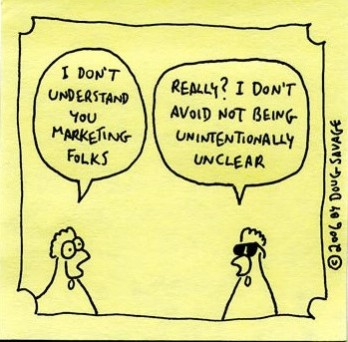If you flap lips to Kotler, turn blue rattling 4Ps, 5Cs, 7S, 9Ms , 12Ws and other alphanumeric marketing frameworks, this list of marketing jargon will smell of freshly starched white cotton shirt on classic blue washed denims, getting you ready to hit the road running
- Age Compression: young kids marketed adult or older children items. Walk through apparel line up in the kids section and you would know what I mean. Oh and toys too.
- Aural branding: associating a sound with a brand. Ting ting tiding- rings a bell?
- Autoagents: software which attempts to second-guess your consumption patterns. Digital Marketers this is lifeline.
- Bait and switch: Entice the discount shoppers with advertisements of low priced items. They land and woof items are sold out, always! You have been clicking on those ads and entering showrooms with those sales haven’t you.
- Beat the bushes: If you find saying marketing to bottom of the pyramid, unconventional or rural areas hackneyed here is your alternative.
- Betamaxed: When better marketing for an inferior product wins.
- Blow-in: Advertising materials inserted between the pages of a newspaper and magazine that you painfully remove and delightfully sell a.k.a flyers.
- Boilerplate: Standard legal wording used company or industry-wide. Since no one really reads it, this is a great place to be sneaky. T&C apply.
- Brand Conscious babies: Reducing gap between popping out and recognizing brands! = Hole in pocket.
- Brand terrorist: An employee who is undermining the organization. Quite the opposite of a brand custodian
- Brandalism: sticking company logos on everything and anything. STOP!
- Brandatories: Brand+ Mandatory = all the branding elements that must be included in a given ad or campaign.
- Captive Kidspace: places business can sell to kids, knowing that they can’t escape. Schools.
- Conspicuous non-consumption: a type of snobbery based on what an individual chooses not to buy.
- Corporate logowear: apparels that scream the company’s logo.
- Corporate vanity publishing: when businesses pay vast sums to produce beautiful coffee table books about themselves, their histories and their visions. The only people who will ever read these are the proofreaders at the publishing house.
- CPS Cheap Plastic Shit: Promotional items (often made of plastic) distributed through advertising, corporate gifts, trade shows, or other give-away programs. Made in _____.
- Drink our own champagne: A term meaning that a business will use the same product that they sell to their customers. The marketers at Cola companies are sworn loyalists!
- FUD factor: Cheat sheet for selling: Create Fear, Uncertainty, and Doubt in the customers mind and then bring upon your solution. Insurance is an obvious culprit.
- Kebab manoeuvre: packing up low quality products, heavily marketing them and selling at an elevated price
- Less than zero: a customer who costs more to serve than they return in value. Junk them.
- Marketecture: Technical advertising, usually including diagrams.
- Open skies: Universally available.
- Pig in a python: A sudden surge or sharp statistical increase in demographics, spending, age etc.
- Prostitot: A pre-teen girl who dresses provocatively. Ah! for childhood.
- Pucker factor: The degree of reaction to something that is startling or unexpected.
- Reverse logistics: The return of a faulty product to the manufacturer.
- Sausage and the sizzle: Used by sales when comparing substance (sausage) versus marketing spin (sizzle).
- Tart up: To artificially increase the attractiveness of something.
- Windshield survey: Avoiding the effort required to actually get out of the car during a site visit.
- Word-of-mouse: Referral advertising, gossip or information shared over e-mail, blogs or social network.
- Yogurt cities: Places that have an ‘active culture’, meaning a large number of museums, theatres, art galleries, etc.
Office Vocabulary I: For the meeting magnate
Office Vocabulary II: Types of Workers


